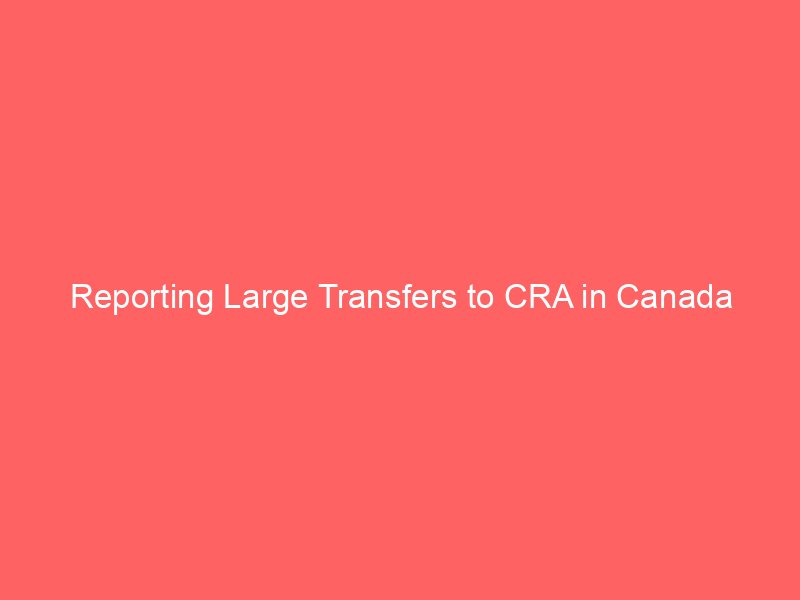CRA has access to over 17 million financial transaction reports each year — all flagged for being over $10,000. So if you’ve ever sent or received a large amount of money, there’s a good chance the CRA already knows.
But what does that mean for you?
Let’s talk about how large transfers are tracked, when you need to report them, and what to expect if the CRA comes knocking.
Do you have to report large money transfers to CRA?
No, you don’t report them directly — but your bank or transfer service does. If you send or receive $10,000 CAD or more in a single transaction, your financial institution reports it to FINTRAC, which may then alert the CRA.
But there’s more to it.
What Qualifies as a “Large” Transfer?
The magic number is $10,000 CAD.
If you send, receive, deposit, or withdraw this amount in cash, it gets reported automatically.
This rule applies to:
- Banks
- Credit unions
- Western Union, Remitly, Wise
- Crypto exchanges
- Currency exchanges
Who Actually Reports It?
You don’t. Your bank or transfer service is required by law to report large transactions to FINTRAC (Financial Transactions and Reports Analysis Centre of Canada).
From there, FINTRAC may share that info with CRA, RCMP, or CSIS if it looks suspicious.
What Does CRA Do With That Info?
If you’ve paid your taxes and your money is clean, nothing happens.
But if the CRA sees:
- Unreported income
- Repeated large transfers without explanation
- Suspicious patterns
…they may launch a tax audit or investigation.
What Triggers CRA Review?
Here’s what might catch their eye:
- Frequent transfers just under $10,000
- Large amounts from offshore accounts
- Transfers from tax-haven countries
- Inconsistent income vs. lifestyle
Imagine earning $40K a year but sending $100K abroad — that’s a red flag.
When Do YOU Need to Report?
There are two situations where you need to report directly:
1. Foreign Property Over $100,000 CAD
Use Form T1135 if you hold:
- Foreign real estate
- Offshore bank accounts
- Foreign stocks/bonds
2. Business-Related Transfers
If you’re self-employed and sending or receiving money as part of your business, it should be included in your business income.
What Happens If You Don’t Report?
If CRA finds undeclared income or foreign assets, they can:
- Reassess your taxes
- Add interest and penalties
- Launch a criminal investigation
Worst-case? Jail time for serious tax evasion.
How to Stay Safe and Compliant
- Keep detailed records – transfer receipts, bank statements, contracts
- Disclose foreign assets – especially if over $100,000 in value
- Don’t “structure” transfers – that’s illegal
- Get advice – talk to a tax pro if you’re unsure
Multimedia Suggestions
- Infographic: “How CRA Tracks Large Transfers”
- Flowchart: “What Happens After a $10,000+ Transfer?”
- Video: A walkthrough of Form T1135 with a tax expert
Data Suggestions
- CRA audit statistics related to remittances
- FINTRAC data on suspicious transaction reports
- Number of Canadians fined for failing to report foreign assets
Key Takeaways
| Topic | Summary |
|---|---|
| $10,000 transfers | Automatically reported by your bank |
| CRA involvement | Triggered by suspicious or unexplained activity |
| Your reporting duty | Only applies if you hold foreign assets or are self-employed |
| Avoid penalties | Keep records, be honest, and consult a professional |
FAQs on CRA and Large Transfers
Do I report a $15,000 wire transfer to CRA?
No, your bank does. But keep records in case CRA asks.
What if I receive $20,000 from overseas?
It’s not automatically taxed. But CRA may ask for proof of source if it seems unusual.
Can CRA see my bank transfers?
Yes — through reports from FINTRAC. Especially for amounts over $10,000.
What if I forget to file Form T1135?
You could face fines starting at $2,500. File it if you own foreign property worth $100K+.
Final Thoughts
The CRA isn’t watching every dollar you move — but large amounts do get flagged.
You don’t have to panic. You just need to be prepared, honest, and organized.
If you’re dealing with large or foreign transfers on the regular, it’s worth having an expert in your corner.
